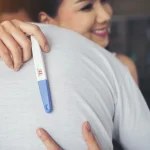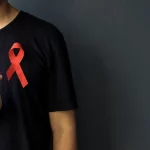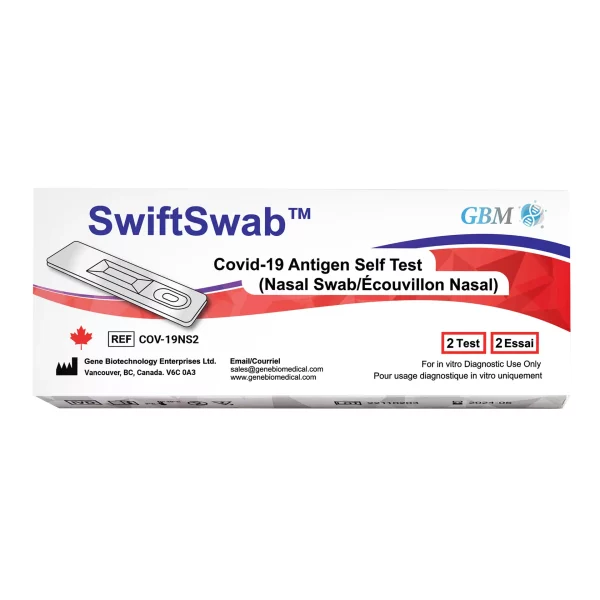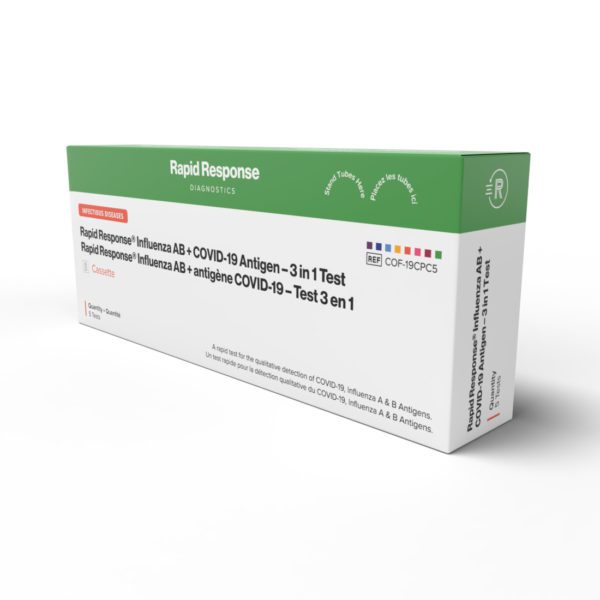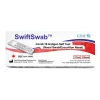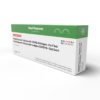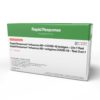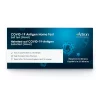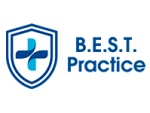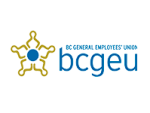This article provides tips on how to make rapid testing part of your strategy to stay healthy and prevent the spread of the coronavirus this holiday season.
The pandemic made last Christmas a bleak one, with COVID cases at their peak and vaccines and rapid tests hard to get. But a year later, we seem to be in much better shape.
Vaccination rates are increasing, and the surge of the Delta variant appears to be behind us. The holiday season is again on the horizon, and many people want to know if they can travel safely to see friends and family.
Experts agree that COVID vaccinations protect most people from the risk of severe illness and death. They also limit the spread of the virus, including new variants.

Of course, some people, including seniors, young children, and people who are immunocompromised, cannot get the vaccine. If any of your friends or family fall into these groups, you’ll probably want to do everything you can to keep them safe and healthy during the holidays.
Aside from getting vaccinated, what other steps can you take to have a traditional holiday celebration like you did before the pandemic? Rapid testing can be part of your seasonal strategy to stay healthy and prevent the spread of the coronavirus.
COVID testing can get confusing because there are several types of tests used to detect the virus. The two main types of tests are diagnostic and antibody tests, and they are not interchangeable. Here are some of the differences between these two tests:
Diagnostic Testing
Diagnostic tests determine if you currently have a COVID-19 viral infection. These tests can be either molecular- or antigen-based, but they both work by detecting the presence of genetic material from the virus.
Molecular tests use samples either from saliva or a nasal swab, while antigen testing relies on nasal swabs to take a sample. Results from diagnostic tests are fast; you may know if you test positive in as little as 15 to 30 minutes.
The only downside to diagnostic testing is that the accuracy of the results depends on when you are tested. It is possible to have the virus without the test detecting it, especially if you use it too quickly after exposure.
Frequent testing can solve this problem, which is why you should keep rapid tests on hand to use before traveling for the holidays, hosting people at your home, or visiting with people who cannot take the vaccine.
Antibody Testing
Tests that detect antibodies are not used to see if you have an active COVID-19 infection. Instead, they can tell you if you have had an infection and developed antibodies, indicating an immune response.
These tests use a blood sample, either from a finger stick or vein. Testing takes place in a lab, and the results can take up to three days to come back from the lab.
Detecting antibodies does not mean that you cannot contract or transmit the virus. A positive antibody outcome only means that you have evidence of a previous infection. Variants of the COVID-19 virus can cause breakthrough infections in people who already had COVID or the vaccine, which is why continued, regular diagnostic testing is so important.
How Can You Test Yourself at Home?
Once you have a supply of test kits from Rapid Test & Trace, you can test yourself and your family members when you decide it is appropriate. These testing kits are similar to at-home pregnancy tests and just as easy to use. For the most accurate results, just follow these steps:
- Insert the sterile swab 2 centimeters inside your nostril, rotating it for about 15 seconds. Repeat in your other nostril.
- Put the swab inside the tube included with your test and add the testing solution if it is not already in the tube.
- Pinch the tube while removing the swab to squeeze out any extra solution.
- Add the nozzle to the end of the tube and squeeze it to allow drops of the sample to permeate the cassette well. The cassette is the item that may resemble a pregnancy test stick.
- Wait 15 to 30 minutes to read your results. One line is the control line. If a second line develops, even faintly, that indicates a positive result.
Be sure to read over the directions in the rapid test before using it so that you understand how it works. The swab is not nearly as invasive as earlier versions of COVID-19 testing; you should not have any discomfort when using it.
What Are the Advantages of Rapid Antigen Testing?
Whether you’re traveling for the holidays or hosting friends and family at your home, you have plenty of things to do. Between shopping, gift wrapping, cooking, and cleaning, who has time to schedule an appointment to get tested for COVID-19?
Rapid testing solves the problem – you can get a pack of tests delivered to your home for you and your family to use before you leave or your visitors arrive. If you wait until the last minute to shop for tests, you may not find any, thanks to the ongoing supply chain issues.
Here are even more benefits of rapid home tests:
- Accuracy – Most rapid antigen tests are up to 98 percent accurate. Occasionally, you may get a false-positive result. Still, most of the time, you can feel comfortable knowing that a negative result means that you do not have detectable levels of viral particles when you administer the test.
- Safety – Rapid testing is safe for people of all ages, including young children who are not yet eligible for vaccination. With family get-togethers planned for the holidays, this provides peace of mind that your children are not exposing older family members to the virus.
- Efficiency – A test that is easy to understand and use at home or when traveling is a significant advantage over scheduling an appointment and waiting days to get your results. With rapid testing, you can take the test and wait for your results in less than an hour. That level of convenience and ease is a bonus when your life is already hectic with holiday preparations.
- Affordability – Testing through clinics or medical offices may come with a fee, especially if the health service or insurance does not consider testing medically necessary. Under these circumstances, you may be responsible for any expenses related to extra testing. Purchasing rapid antigen tests may have lower out-of-pocket costs than testing at other locations.
When you order a set of home tests from Rapid Test & Trace, you’ll have supplies on hand to use or share with your family and friends. If everyone plays a part in protecting the most vulnerable members of our community, especially young children, older people, and those with weakened immune systems, together we can limit the transmission of COVID-19 and its variants.
Where Can You Get a Diagnostic Test?
Many communities continue to offer COVID-19 testing at designated testing sites. Your doctor’s office or clinic may provide testing, or they may prescribe a test that you can get at another location.
Finding over-the-counter tests can be challenging because they continue to be in high demand. When preparing for holiday travel, the last thing you want to do is call or drive around town to locate a rapid test you can use before you leave.
At-home testing may be the ideal solution. With rapid testing you can use at home, you can test yourself and know the results in a matter of minutes. It’s hard to beat the convenience of receiving rapid home tests in the mail that you can use a few days before traveling to ensure you do not have the virus.
Providing negative test results continues to be a condition to enter some facilities or travel to particular destinations. Not only can you adhere to these requirements, but you can also evaluate yourself at your convenience. Just add rapid testing to your list of things to do when you get ready for any holiday travel to be prepared.
What Can Your Results Tell You?
Rapid testing for COVID-19 is highly accurate but not 100% effective. The incubation period for a COVID infection is anywhere from two to 14 days. If you test yourself too soon after potential exposure, you might see a negative result but still have the virus.
One of the main problems with COVID detection is that not everyone who gets the virus has symptoms. Some people mistakenly think they do not have COVID and go about their everyday lives, unaware that they are exposing other people to the virus. Those people may, in turn, develop life-threatening infections and require hospitalization and ongoing treatment to recover.
It’s alarming enough to inadvertently expose strangers to this viral menace, but what if you expose your friends or family? The last thing you want is to infect the people you love when visiting during the holidays, especially when a simple rapid test could inform you whether it is prudent to cancel your travel plans.
An intelligent approach is testing to wait a few days to test if you think you may have come in contact with COVID, and then test yourself again a few days after that. Two negative test results within days of each other are a good indication that you do not have COVID and give you a more precise assessment of your risk.
Even the most accurate tests can only indicate your infection state at the moment you are tested. It cannot inform you of a previous infection, nor can it predict the potential of an infection a few hours or days from when you first took the test.
Can You Take Other Steps to Prevent the Spread of COVID-19?
Rapid testing and vaccinations help slow the spread of the virus, but other basic precautions are also helpful. These recommendations continue to be effective:
Washing your hands for at least 20 seconds with soap and water can kill most viruses and bacteria. If you do not have access to a sink, use hand sanitizer, concentrating on your fingertips and palms, which come in contact with frequently used surfaces.
If you have any symptoms, including fever, muscle or body aches, chills, shortness of breath, fatigue, or loss of smell or taste, cancel your holiday travel plans and stay home. It is better to isolate yourself and connect by phone or video chatting than to expose your loved ones to a deadly virus.
Try to self-quarantine for up to 14 days before you travel. This two-week period may not work with everyone’s work schedules, but if working from home is an option, use it to minimize your exposure to other people to prevent viral exposure before your trip.
Test at least five days before you leave. Better yet, test twice with your rapid home tests to get two negative results. If you think your test results are false positives, try again or consult your medical provider for a molecular diagnostic test to see if the results match those from your rapid antigen test.
Consider driving rather than flying, if possible, to limit your exposure to other people. Crowded airports and fully booked airplanes are prime spots to encounter the virus, especially if not everyone complies with mask mandates.
Testing is most effective if everyone participates. Encourage other family members or friends to also use rapid testing before gathering. When you are the host, you may want to request your guests use a home test a few days before attending your event.
Where Can You Get Accurate, Affordable Rapid Tests?
What better way to get into a festive mood than by protecting your loved ones and preventing exposure to COVID-19? At Rapid Test & Trace, our mission is to democratize rapid testing in Canada and beyond. We provide rapid testing options you can use before you celebrate the holidays or any time you want to prevent the spread of COVID.
Visit us online or contact us with any questions you have about our rapid testing supplies for a safe and merry holiday season.


